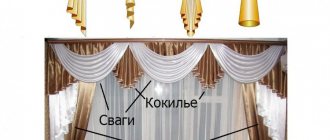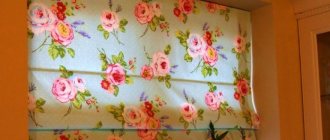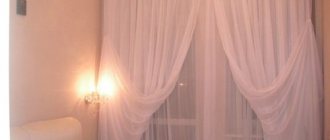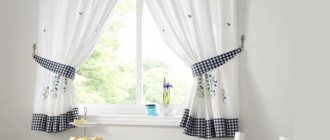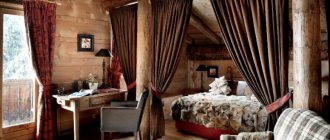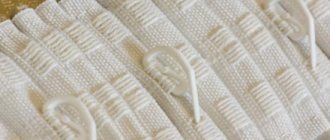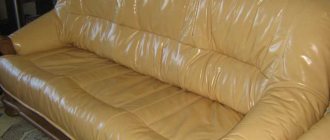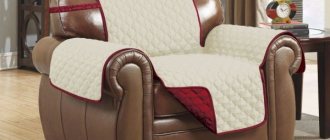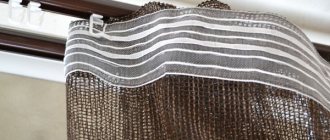Home textiles are used to create a harmonious interior, giving the overall composition bright and stylish accents. It will not be difficult for a home craftsman to sew curtains or curtains on his own, but for this it is important to understand the sewing technology and choose an interesting and original idea.
Beautiful curtains for the kitchen or for the nursery, living room and even bedroom will become a real decoration of the room and will perform a practical function. Such products are used not only as decoration for window openings, but also provide measured penetration of natural light into the room.
What styles can be mastered without sewing equipment?
There are several stages in sewing curtains, but the most important thing is not to make mistakes in the measurements. It happens that there is a piece of beautiful tulle or a ready-made lambrequin, but it is not enough for a whole window. Or there are curtains from another room that have to be reformatted to fit another window opening. You have to use your imagination and experiment with what you have.
When thinking about how to sew curtains with your own hands from existing fabric, it is important to decide on the style. Japanese curtains do not require special skill - it is important to equip narrow curtains with a movable mechanism purchased from sewing accessories departments.
For smooth screened panels you need a special electrically driven cornice. Any workshop will help you cut off the edges and overlay the edges of the panels.
In a similar way, you can solve the issue with roller blinds. A special lifting mechanism that winds a strip of fabric onto a roller is easy to find in a specialized store - the package includes instructions for assembly and fastening. All that remains is to cut out the suitable fabric and take it to the studio to process the seams.
In some cases, it is not necessary to have sewing skills, but it is good to know how to crochet. A curtain made using the fillet technique, where the pattern is formed by alternating empty and filled windows, will decorate a kitchen or a child’s bedroom window.
Using a crochet hook from leftover yarn, you can make rope or thread curtains yourself, decorating them with beads, pom-poms or tulle balls.
A curtain with wide hinges is the same rectangular panel, processed along the edges by a craftsman from the studio. Loops can be sewn from thick satin ribbon in the color of the fabric at a certain interval. This mount fits directly onto a rounded plastic or metal curtain rod, creating a light wave-like assembly.
There is nothing difficult about how to sew curtains with eyelets with your own hands. These are rings through which a rounded cornice is threaded. To do this, the curtain fabric on top is folded into a wide strip, on which through holes are made for fastenings.
Note! Eyelets come in different sizes and shapes and are made of wood, plastic or metal. You can choose the most suitable version for your cornice, the main thing is that the rod of the cornice passes through the internal holes of the original fastening.
Materials, tools and accessories for sewing curtains
The textile product must be properly processed on the front and back sides. Therefore, to make beautiful and practical curtains with your own hands, each seamstress will need certain accessories for work, namely:
- textile;
- curtain holders;
- cornice with accessories;
- sewing machine;
- multi-colored threads for basting and sewing curtains;
- sewing pins;
- scissors;
- tape measure;
- sewing needles;
- long ruler;
- iron for wet-heat treatment.
Today, sewing a product can be done independently according to calculations, directly on the fabric and using a pattern. It is used for more complex curtain models, for example, for products with lambrequins. Let's look at several basic curtain options for which you won't need curtains.
What is important for a beginner to know about curtain fabrics
Each curtain style has its own nuances. In any case, the method of fastening and the length of the finished window curtain are taken into account - after all the assemblies and draperies. A preliminary drawing is a guarantee of correct calculations.
Note! A sketch of a future curtain is not just a rectangle with a traditional understanding of length and width! A different definition of format is used here.
The length of the curtain is measured from the cornice to the floor, with an error depending on the method of fastening and the method of drapery. Width – parameters of the window opening from wall to wall, with an error for assembly when forming folds, processing the edges of the canvas and the exit of the finished product beyond the window by 35-40 cm.
When choosing a style, you have to compare the measurements with the actual width of the fabric. Tulle rolls are designed for cross-stitching; their cross-sectional width is usually designed for standard city apartment walls.
Some curtain fabrics have a difficult to determine face and back, but the side edges usually have a more unkempt appearance, with the ends of the threads visible. The paint is always paler on the inside.
When sewing on the fastening, it is important not to confuse where is the top and where is the bottom. Even plain fabrics may have a different direction of the pile or weaving of the threads that form the texture. Therefore, it is so important to compare 2 identical panels of tulle or curtains.
Helpful advice! To avoid defects on a piece of fabric, it must be completely unfolded before the store issues a receipt. If the purchase cannot be returned or replaced, you will have to reconsider the style or cut the fabric in half, and try to hide the defective parts of the curtain under the curtain.
Performing calculations
There cannot be a single calculation formula for curtains. Each model is unique. In any case, be sure to pay attention to the length and width of the canvases. Take into account the placement of folds, drapery, and the possibility of assembly. It is important to pay attention to the type of cornice and provide a system for securing the fabric to the holder.
Note!
- DIY satin ribbon bows - step-by-step instructions for creating unusual bows + detailed diagrams with photos
- Do-it-yourself furniture restoration: step-by-step master classes on restoration at home (120 photo ideas)
Do-it-yourself rack: step-by-step instructions with photos and descriptions on how to make an unusual rack
Assembly coefficients
When selecting fabric for sewing curtains yourself, it is important to take into account all the nuances. For example, if these are two panels of colorful fabric, then the pattern will not match if you simply cut a piece of material in half. In this case, they add another half of the pattern repeat, and when cutting, look at the combination of the pattern.
For some styles, it is difficult to find a roll of fabric that is enough to cover the format of the window opening.
Understanding how to sew a French curtain with your own hands, it becomes clear that you cannot do without sewing together several panels. The cuts are hidden in rows of assembly, which forms thick sagging coattails.
Important! When selecting fabric for an awning, the format of the finished curtain in width and height is multiplied by 3. Additionally, allowances for seams, hems and fastening strips are taken into account.
Calculations of how much fabric is needed for a curtain with soft folds, sewn onto curtain tape with ready-made loops:
- To measure the width of the window opening, add 40 cm on both sides so that the fabric blocks the side light. Accordingly, the cornice must be wider than the window format (at least 20 cm, not counting the parts extending beyond the brackets).
- We multiply the total width by 1.5 - this is the assembly factor. It is necessary for free sagging of soft folds. If these are folded bow or counter folds, multiply the width by 2.
- We add another 3-4 cm to the obtained measurements; this is a reserve for cutting edges and processing the fabric.
- We make adjustments along the length of the curtain, adding to the finished format (from the cornice to the floor) seam allowances and a hem for fastening - approximately another +10 cm.
The standard gather factor (CS) differs for different styles and types of fabric. For example, for smooth curtains on both sides of the tulle, KS = 1.3. The same figure for retractable curtains without assembly is 1.7. If curtains are sewn with folds from thick fabric, KS = 2. Separately, fabric is collected for lambrequins and decorative details, making calculations using ready-made patterns or patterns shown in the figure.
When choosing a tulle style, the location of the balcony door, pipes and heating radiators is also taken into account - it is advisable to hide this under textiles. If the batteries are new, stylish in design or covered with a decorative shield, you can save on the length of the tulle.
The standard length can vary from the window sill to the middle of the battery, the bottom edge can also be varied.
In order not to worry about whether there is enough fabric for a regular tulle with soft folds, feel free to add 1 meter to the side margin and multiply the measurements by 2. This will eliminate “under-measurement”, and the remaining fabric can be used for accessories.
Most curtains have a simple rectangular pattern, so you should decide to sew the curtains yourself - this will reduce the cost of updating your window decor by about half.
If you are wondering how to sew a Roman blind with your own hands, then the determining factor here will not be the consumption of fabric, but the presence of fastening equipment with a lifting mechanism.
Additional decorations
Even the simplest curtain models will sparkle in a completely new way if you complement them with various decorative elements.
Lambrequins
Lambrequins will give a sophisticated and chic look to even the simplest options.
You will need:
- fabric (usually the same as when sewing curtains);
- threads in color;
- bias tape.
Step by step guide:
- Lambrequins account for approximately 1/5 of the total footage of curtain fabric. It looks something like one vertical classic curtain. Also decide how many divisions you will have; the standard is two to three. Take the fabric and mark the folds, securing with pins. The main thing is that the length is enough for the entire length of the window.
- If all the calculations satisfy you, then remove the pins and process the edges. The bottom is best treated with a special bias tape:
- Simply hem the side sections by folding 5 mm, and then another 7-10 and stitching along the edge. Treat the top in the same way.
- Now, in the same way as you outlined the folds, create them again and secure them by stitching on a typewriter. The seams can be decorated with decorative flowers, beads, etc.
The advantages of lambrequins are that they are not difficult to manufacture and, at the same time, significantly decorate the room.
Roses for curtains
There are two ways to make roses for decorating curtains:
- Simple. Making such a flower is not difficult even for a child, so you can safely involve your children in sewing. You need to take a fabric or satin ribbon, about 10 cm wide. The length should be taken at your own discretion; the longer the blank, the larger and more magnificent the rose will be. Fold the fabric in half lengthwise, right side inward, and start stitching, stitching along the very edges of the workpiece. Then turn it inside out. Start rolling the rose like a roll, trying to make it tighter at the base and looser towards the top. Secure the base with threads. As a result, you should end up with a flower like this:
- By petals. This method involves making a rose from separately collected petals. It is necessary to cut out approximately round petals of different sizes. The shape and size are not of particular importance, since flowers created by nature cannot be perfectly even and symmetrical. Therefore, the less you worry about this, the more natural your rose will turn out. It is easiest to process the cut petals with fire so that the edges do not crumble. You can also do this using bias tape. This is a more complex, but at the same time, more interesting option, especially if you take a ribbon of contrasting color. After the petals are fully prepared, begin to collect them using the following scheme:
As a result, you will get a very realistic and beautiful flower.
What to do if there is an error in measurements?
A common mistake made by beginning seamstresses is “under-measuring,” which became obvious when the curtains and drapes were already hanging. In this case, the fabric may not be enough in width or length.
The money has been spent, but the solution to the issue of decorating the window opening remains stuck.
The problem with the length of the canvas can be solved in different ways:
- Finish the curtain at the bottom with a wide border or frill made of a similar fabric, but with a pattern or figured bottom.
- Decorate it in an original way on top, where the panel is attached to the cornice, decorating it as part of the decor.
- Lower the cornice slightly or replace the ceiling version with a wall-mounted model if altering is not possible.
- Cutting the bottom with an arch or along an oblique line (diagonally), decorating it with a satin trim is a good option for a window opening with a balcony door. All sewing supply stores offer ready-made bias tape in all colors.
- Sew fringe or other original decor on the bottom.
How to sew curtains for the bedroom with your own hands if there is not enough fabric?
The lack of fabric along the width of the window opening can be easily compensated for with colored blocks on the sides or an unusual insert in the center. This can be thread muslin or a shortened decorative piece with gathers at the bottom.
A good option is to combine curtain styles of different lengths, for example, an Austrian curtain or a French “awning” in the center of the composition with long curtains lying on the floor.
How to choose curtains for windows
Decorative pillows, bedspreads and textiles on the windows should be combined with soft upholstery.
In this case, the style of curtains can be different:
- In a strict style.
- Flirty-romantic style.
There can be two ways here:
- Buy ready-made curtains.
- Sew beautiful curtains yourself. In this case you must have:
- several photo examples to determine the direction;
- wish;
- patience and perseverance;
- expert advice.
In addition to the fact that the price of such curtains will be much lower, the process of making them yourself is also interesting.
Self-made curtains
Tip: Although you can buy ready-made curtains, it is better to sew them yourself. A large selection of materials and original designs will allow you to transform your bedroom, making it individual, unusual, beautiful and elegant.
Fabric consumption for different styles
Curtain, from the French word “store”, translates as “fabric curtain”. “Tulle” (a masculine word) is consonant with the city where this light translucent fabric was invented at the textile manufactory.
Each cultural era offered its own style, but the name does not always coincide with the place of origin.
The most common curtain styles:
- French "marquise";
- Austrian curtain (with soft gathers at the bottom and two tiebacks);
- English multi-layer curtains (with folds and fringes, often made of velvet or velor);
- Roman (with uniform folds and a lifting mechanism);
- Italian (narrow long canvases with interceptions in the middle, often used to fill the piers on bay windows);
- Japanese (smooth screened curtains with a weighting material at the bottom edge, require special movable curtain rods with remote control and electric drive).
This is a design classification, it is very conditional, but it makes it easier to determine how complex the tailoring will be. Each type requires its own type of fastening - on a baguette, cornice or ceiling strip with runners.
The fabric pattern is determined by the style and overall design concept. Narrow fabrics are suitable for roller and Japanese curtains.
Today, many single-layer and multi-level curtain compositions, simple and complex styles have been developed. There are single curtains without drapes and multi-layer curtains with draperies, tiebacks and pelmets or color blocks.
Kitchen curtains can be decorated with ruffles and frills, but this is not always appropriate in a strict modern bedroom.
Roman design
Curtains in the Roman style are radically different from the usual classics. For sewing, it is recommended to use dense, noble-looking fabrics:
- atlas;
- muslin;
- jacquard.
You can make a complex structure from several panels or stop at a single leaf. Roman curtains are laconic and economical. The option does not require a lot of fabric or complex accessories. Before doing it yourself, it won’t hurt to familiarize yourself with the step-by-step instructions: how to make Roman blinds.
Photos of beautiful hand-sewn curtains
Share with friends:
Where to start?
First, determine the model of curtains that you like. It is important to decide what the purpose of the future product is. Functionality or aesthetics may come first.
Start by looking at sketches of curtains; you need to find out how closed the window opening will be, how to make patterns, what additional elements will be needed to sew the design. Read the original instructions for beginners, it will help you understand every step.
Now you can start taking measurements. You will also need to find out which curtain dimensions will suit you best. Do not ignore certain nuances:
- The length of the cornice matches the minimum size. Protect yourself from intense natural light by adding approximately 20 cm.
- For fans of styles with folds, an additional 1/3 of the length is added to the length of the cornice.
- Curtain length is affected by many factors. The product must match the style of the interior. Your fantasies and preferences play not the least role. The canvas can completely cover the window, reach the floor, or cover only 1/3 of the window. For a short model to look beautiful, the curtain must completely hide the upper wall.
Cutting out the scarf model
The result is a one-piece fabric, which is secured by hand to the cornice. Take a look at the photo of the curtain patterns; the proposed design solutions are comparable to classic models. The height of the swag should not exceed 1/6 of the window.
The scarf model is considered one of the lightest, so it can be cut on fabric. It is important to follow certain rules:
- Determine the length of the curtain rod and the height of sag you need. Imagine what a lambrequin decorated with embroidery will look like. For this purpose, hang a cord on the cornice, mark the value for the height and the length of the sag.
- At the top, mark the middle to set aside the tails.
- Below from the center, mark the sag arc. Connect the marks with the marks along the width of the cornice. Sew the braid along the marked line
- Pull the material together and decorate the tie with bows or other decor.
Methods of joining fabrics
There are times when it is necessary to sew together several pieces of the same material, to combine fabrics that are different in type, color, density, texture. This will give the product a certain style. There are many options for connecting segments, the main ones include:
- vertical;
- horizontal;
- double;
- short curtains over long ones;
- with edging around the perimeter;
- with a corset.
Depending on the type of connection, a method is selected by which several parts of the material can be sewn together. There are two main bonding methods:
- Using a triple seam. To do this, two parts are connected with the wrong sides. Stepping back 5 mm from the edge, a stitch is made. The remaining small allowances of the two parts are folded towards the seam, ironed, after which another line is made along the very edge. The resulting edge is ironed to one side, after which it is stitched to the fabric along its edge.
- Decoration with ribbon. All the same steps are performed as in the first option, only on the front side, after which the edge is hidden under the decorative tape.
Making a swag pattern
For work, prepare a vertical surface and a multiplier cord. You will:
- On the top of the pattern, mark the estimated width of the swag; to do this, mark 3 points – 1,2,3.
- Then divide the distance 1 and 2 into 3 equal parts and mark 2 more points here - 5.6.
- Determine the height h and mark it with point 4.
- Connect 1, 2 and 4 together. Use a special rope for this. Tie a simple pencil to one end and a needle to the other.
- You can start shaping the circle from below. The height, designated 4-4a, is a percentage of the curtain width of 50-80%.
- Connect 5 with 6 to get a straight line 1a-2a, marking the place of the folds.
- Don't forget to allow 2cm of seam allowance.
